Submitted:
01 May 2023
Posted:
05 May 2023
You are already at the latest version
Abstract
Keywords:
1. Introduction
2. Materials and Methods
2.1. Study Area
2.2. Remote Sensing Data
2.3. Data analysis workflow
2.4. Pixel pre-processing
2.5. Seasonal decomposition
2.6. EVI upper envelope calculation
- if , i.e. the iteration-fit curve continually increased, the fit of the first iteration was taken,
- if after 10 iterations, the condition was not met, i.e. iteration-fit curve continually decreased, the fit of the last iteration was taken.
2.7. Assessment of statistical significance
2.8. Spatially-averaged time series
2.9. Statistical correlations
3. Results
4. Discussion
5. Conclusions
Author Contributions
Funding
Institutional Review Board Statement
Informed Consent Statement
Data Availability Statement
Acknowledgments
Conflicts of Interest
Abbreviations
| MDPI | Multidisciplinary Digital Publishing Institute |
| BWh | Hot arid desert |
| BWk | Cold arid desert |
| BSk | Cold arid steppe |
| ET | Polar Tundra |
| GS | Greening Strip |
| NDVI | Normalized Difference Vegetation Index |
| EVI | Enhanced Vegetation Index |
| LAI | Leaf Area Index |
| MODIS | Moderate Resolution Imaging Spectroradiometer |
| SST | Sea Surface Temperature |
| LST | Land Surface Temperature |
| ROI | Region of Interest |
| ITCZ | Intertropical Convergence Zone |
| ENSO | El Niño Southern Oscillation |
References
- Holdridge, L.R. Determination of world plant formations from simple climatic data. Science 1947, 105, 367–368. [Google Scholar] [CrossRef]
- Kottek, M.; Grieser, J.; Beck, C.; Rudolf, B.; Rubel, F. World map of the Köppen-Geiger climate classification updated 2006.
- Köppen, W. Klassifikation der Klima nach Temperatur, Niederschlag und Jahreslauf. Petermanns Mitt 1918, 64. [Google Scholar]
- Beck, H.E.; Zimmermann, N.E.; McVicar, T.R.; Vergopolan, N.; Berg, A.; Wood, E.F. Present and future Köppen-Geiger climate classification maps at 1-km resolution. Scientific data 2018, 5, 1–12. [Google Scholar] [CrossRef] [PubMed]
- Drennan, P.M.; Nobel, P. Responses of CAM species to increasing atmospheric CO2 concentrations. Plant, Cell & Environment 2000, 23, 767–781. [Google Scholar]
- D’Odorico, P.; Laio, F.; Ridolfi, L. Vegetation patterns induced by random climate fluctuations. Geophysical Research Letters 2006, 33. [Google Scholar] [CrossRef]
- Suc, J.P. Origin and evolution of the Mediterranean vegetation and climate in Europe. Nature 1984, 307, 429–432. [Google Scholar] [CrossRef]
- Magyari, E.; Jakab, G.; Bálint, M.; Kern, Z.; Buczkó, K.; Braun, M. Rapid vegetation response to Lateglacial and early Holocene climatic fluctuation in the South Carpathian Mountains (Romania). Quaternary Science Reviews 2012, 35, 116–130. [Google Scholar] [CrossRef]
- Gitay, H.; Suárez, A.; Watson, R.T.; Dokken, D.J. Climate change and biodiversity 2002.
- Mooney, H.; Larigauderie, A.; Cesario, M.; Elmquist, T.; Hoegh-Guldberg, O.; Lavorel, S.; Mace, G.M.; Palmer, M.; Scholes, R.; Yahara, T. Biodiversity, climate change, and ecosystem services. Current opinion in environmental sustainability 2009, 1, 46–54. [Google Scholar] [CrossRef]
- Scholes, R.J. Climate change and ecosystem services. Wiley Interdisciplinary Reviews: Climate Change 2016, 7, 537–550. [Google Scholar] [CrossRef]
- NOAA. Global Monitoring Laboratory - carbon cycle greenhouse gases, 2022. https://gml.noaa.gov/ccgg/trends/global.html.
- Joos, F.; Spahni, R. Rates of change in natural and anthropogenic radiative forcing over the past 20,000 years. Proceedings of the National Academy of Sciences 2008, 105, 1425–1430. [Google Scholar] [CrossRef]
- Friedlingstein, P.; Jones, M.W.; O’Sullivan, M.; Andrew, R.M.; Bakker, D.C.; Hauck, J.; Le Quéré, C.; Peters, G.P.; Peters, W.; Pongratz, J.; et al. Global carbon budget 2021. Earth System Science Data 2022, 14, 1917–2005. [Google Scholar] [CrossRef]
- Ralph Keeling, R., Tans, P.. Trends in Atmospheric Carbon Dioxide, Mauna Loa CO2 monthly mean data, Accessed on March 22, 2022.
- Morison, J.; Lawlor, D. Interactions between increasing CO2 concentration and temperature on plant growth. Plant, Cell & Environment 1999, 22, 659–682. [Google Scholar]
- Mishra, N.B.; Mainali, K.P. Greening and browning of the Himalaya: Spatial patterns and the role of climatic change and human drivers. Science of The Total Environment 2017, 587, 326–339. [Google Scholar] [CrossRef] [PubMed]
- Young, B.; Young, K.R.; Josse, C. Vulnerability of tropical Andean ecosystems to climate change. Climate change and biodiversity in the tropical Andes. SCOPE, IAI 2011, pp. 170–181.
- Romero, H.; Ordenes, F. Emerging urbanization in the Southern Andes. Mountain Research and Development 2004, 24, 197–201. [Google Scholar] [CrossRef]
- Nottingham, A.T.; Turner, B.L.; Whitaker, J.; Ostle, N.; Bardgett, R.D.; McNamara, N.P.; Salinas, N.; Meir, P. Temperature sensitivity of soil enzymes along an elevation gradient in the Peruvian Andes. Biogeochemistry 2016, 127, 217–230. [Google Scholar] [CrossRef]
- Horgan, F.G. Effects of deforestation on diversity, biomass and function of dung beetles on the eastern slopes of the Peruvian Andes. Forest Ecology and Management 2005, 216, 117–133. [Google Scholar] [CrossRef]
- Bax, V.; Francesconi, W. Environmental predictors of forest change: An analysis of natural predisposition to deforestation in the tropical Andes region, Peru. Applied geography 2018, 91, 99–110. [Google Scholar] [CrossRef]
- Best, B.; Kessler, M. Biodiversity and conservation in Tumbesian Ecuador and Peru; Vol. 218, BirdLife International Cambridge, UK, 1995.
- Devenish, C.; Nuñez Cortez, E.; Buchanan, G.; Smith, G.R.; Marsden, S.J. Estimating ecological metrics for holistic conservation management in a biodiverse but information-poor tropical region. Conservation Science and Practice 2020, 2, e153. [Google Scholar] [CrossRef]
- Stattersfield, A.J. Endemic bird areas of the world-Priorities for biodiversity conservation. Bird Life International 1998. [Google Scholar]
- Ioris, A.A. Water scarcity and the exclusionary city: The struggle for water justice in Lima, Peru. Water International 2016, 41, 125–139. [Google Scholar] [CrossRef]
- Salmoral, G.; Zegarra, E.; Vázquez-Rowe, I.; González, F.; Del Castillo, L.; Saravia, G.R.; Graves, A.; Rey, D.; Knox, J.W. Water-related challenges in nexus governance for sustainable development: Insights from the city of Arequipa, Peru. Science of The Total Environment 2020, 747, 141114. [Google Scholar] [CrossRef]
- Fragkou, M.C.; McEvoy, J. Trust matters: Why augmenting water supplies via desalination may not overcome perceptual water scarcity. Desalination 2016, 397, 1–8. [Google Scholar] [CrossRef]
- Arp, W. Effects of source-sink relations on photosynthetic acclimation to elevated CO2. Plant, Cell & Environment 1991, 14, 869–875. [Google Scholar]
- Lawlor, D.; Mitchell, R. The effects of increasing CO2 on crop photosynthesis and productivity: a review of field studies. Plant, Cell & Environment 1991, 14, 807–818. [Google Scholar]
- Morison, J.I.; Morecroft, M.D. Plant growth and climate change; John Wiley & Sons, 2008.
- Smith, W.; Donahue, R. Simulated influence of altitude on photosynthetic CO2 uptake potential in plants. Plant, Cell & Environment 1991, 14, 133–136. [Google Scholar]
- Li, Y.; Deng, J.; Mu, C.; Xing, Z.; Du, K. Vertical distribution of CO2 in the atmospheric boundary layer: Characteristics and impact of meteorological variables. Atmospheric Environment 2014, 91, 110–117. [Google Scholar] [CrossRef]
- Rau, P.; Bourrel, L.; Labat, D.; Melo, P.; Dewitte, B.; Frappart, F.; Lavado, W.; Felipe, O. Regionalization of rainfall over the Peruvian Pacific slope and coast. International Journal of Climatology 2017, 37, 143–158. [Google Scholar] [CrossRef]
- Sanabria, J.; Bourrel, L.; Dewitte, B.; Frappart, F.; Rau, P.; Solis, O.; Labat, D. Rainfall along the coast of Peru during strong El Niño events. International Journal of Climatology 2018, 38, 1737–1747. [Google Scholar] [CrossRef]
- Campbell, J.B.; Wynne, R.H. Introduction to remote sensing; Guilford Press, 2011.
- Xie, Y.; Sha, Z.; Yu, M. Remote sensing imagery in vegetation mapping: a review. Journal of plant ecology 2008, 1, 9–23. [Google Scholar] [CrossRef]
- Pettorelli, N.; Vik, J.O.; Mysterud, A.; Gaillard, J.M.; Tucker, C.J.; Stenseth, N.C. Using the satellite-derived NDVI to assess ecological responses to environmental change. Trends in ecology & evolution 2005, 20, 503–510. [Google Scholar]
- Wardlow, B.D.; Egbert, S.L. A comparison of MODIS 250-m EVI and NDVI data for crop mapping: a case study for southwest Kansas. International Journal of Remote Sensing 2010, 31, 805–830. [Google Scholar] [CrossRef]
- Huete, A.R.; Didan, K.; Shimabukuro, Y.E.; Ratana, P.; Saleska, S.R.; Hutyra, L.R.; Yang, W.; Nemani, R.R.; Myneni, R. Amazon rainforests green-up with sunlight in dry season. Geophysical research letters 2006, 33. [Google Scholar] [CrossRef]
- Verbyla, D. The greening and browning of Alaska based on 1982–2003 satellite data. Global Ecology and Biogeography 2008, 17, 547–555. [Google Scholar] [CrossRef]
- Parent, M.B.; Verbyla, D. The browning of Alaska’s boreal forest. Remote Sensing 2010, 2, 2729–2747. [Google Scholar] [CrossRef]
- Bhatt, U.S.; Walker, D.A.; Raynolds, M.K.; Comiso, J.C.; Epstein, H.E.; Jia, G.; Gens, R.; Pinzon, J.E.; Tucker, C.J.; Tweedie, C.E.; others. Circumpolar Arctic tundra vegetation change is linked to sea ice decline. Earth Interactions 2010, 14, 1–20. [Google Scholar] [CrossRef]
- Aide, T.M.; Grau, H.R.; Graesser, J.; Andrade-Nuñez, M.J.; Aráoz, E.; Barros, A.P.; Campos-Cerqueira, M.; Chacon-Moreno, E.; Cuesta, F.; Espinoza, R.; et al. Woody vegetation dynamics in the tropical and subtropical Andes from 2001 to 2014: Satellite image interpretation and expert validation. Global change biology 2019, 25, 2112–2126. [Google Scholar] [CrossRef] [PubMed]
- Carlson, B.Z.; Corona, M.C.; Dentant, C.; Bonet, R.; Thuiller, W.; Choler, P. Observed long-term greening of alpine vegetation—a case study in the French Alps. Environmental Research Letters 2017, 12, 114006. [Google Scholar] [CrossRef]
- Polk, M.H.; Mishra, N.B.; Young, K.R.; Mainali, K. Greening and Browning Trends across Peru’s Diverse Environments. Remote Sensing 2020, 12, 2418. [Google Scholar] [CrossRef]
- Zhang, Y.; Song, C.; Band, L.E.; Sun, G.; Li, J. Reanalysis of global terrestrial vegetation trends from MODIS products: Browning or greening? Remote Sensing of Environment 2017, 191, 145–155. [Google Scholar] [CrossRef]
- Saleska, S.R.; Wu, J.; Guan, K.; Araujo, A.C.; Huete, A.; Nobre, A.D.; Restrepo-Coupe, N. Dry-season greening of Amazon forests. Nature 2016, 531, E4–E5. [Google Scholar] [CrossRef]
- Morton, D.C.; Nagol, J.; Carabajal, C.C.; Rosette, J.; Palace, M.; Cook, B.D.; Vermote, E.F.; Harding, D.J.; North, P.R. Amazon forests maintain consistent canopy structure and greenness during the dry season. Nature 2014, 506, 221–224. [Google Scholar] [CrossRef] [PubMed]
- Sylvester, S.P.; Sylvester, M.D.; Kessler, M. Inaccessible ledges as refuges for the natural vegetation of the high Andes. Journal of vegetation Science 2014, 25, 1225–1234. [Google Scholar] [CrossRef]
- Valencia, B.G.; Bush, M.B.; Coe, A.L.; Orren, E.; Gosling, W.D. Polylepis woodland dynamics during the last 20,000 years. Journal of Biogeography 2018, 45, 1019–1030. [Google Scholar] [CrossRef]
- Rundel, P.W.; Dillon, M.O.; Palma, B.; Mooney, H.A.; Gulmon, S.; Ehleringer, J. The phytogeography and ecology of the coastal Atacama and Peruvian deserts. Aliso: A Journal of Systematic and Floristic Botany 1991, 13, 1–49. [Google Scholar] [CrossRef]
- Sulca, J.; Takahashi, K.; Espinoza, J.C.; Vuille, M.; Lavado-Casimiro, W. Impacts of different ENSO flavors and tropical Pacific convection variability (ITCZ, SPCZ) on austral summer rainfall in South America, with a focus on Peru. International Journal of Climatology 2018, 38, 420–435. [Google Scholar] [CrossRef]
- Fjeldså, J. The avifauna of the Polylepis woodlands of the Andean highlands: the efficiency of basing conservation priorities on patterns of endemism. Bird Conservation International 1993, 3, 37–55. [Google Scholar] [CrossRef]
- Justice, C.O.; Vermote, E.; Townshend, J.R.; Defries, R.; Roy, D.P.; Hall, D.K.; Salomonson, V.V.; Privette, J.L.; Riggs, G.; Strahler, A.; others. The Moderate Resolution Imaging Spectroradiometer (MODIS): Land remote sensing for global change research. IEEE transactions on geoscience and remote sensing 1998, 36, 1228–1249. [Google Scholar] [CrossRef]
- K. Didan. MOD13Q1 MODIS/Terra Vegetation Indices 16-Day L3 Global 250m SIN Grid V006, 2015. [CrossRef]
- Gorelick, N.; Hancher, M.; Dixon, M.; Ilyushchenko, S.; Thau, D.; Moore, R. Google Earth Engine: Planetary-scale geospatial analysis for everyone. Remote sensing of Environment 2017, 202, 18–27. [Google Scholar] [CrossRef]
- K. Didan, A. B. Munoz, R. Solano, A. Huete. MODIS Vegetation Index User’s Guide (MOD13 Series) Version 3.00, June 2015 (Collection 6), 2015.
- Rousseeuw, P.J.; Leroy, A.M. Robust regression and outlier detection; John wiley & sons, 2005.
- Seabold, S.; Perktold, J. statsmodels: Econometric and statistical modeling with python. 9th Python in Science Conference, 2010.
- Chen, J.; Jönsson, P.; Tamura, M.; Gu, Z.; Matsushita, B.; Eklundh, L. A simple method for reconstructing a high-quality NDVI time-series data set based on the Savitzky–Golay filter. Remote sensing of Environment 2004, 91, 332–344. [Google Scholar] [CrossRef]
- Whittaker, E.T. On a New Method of Graduation. Proceedings of the Edinburgh Mathematical Society 1922, 41, 63–75. [Google Scholar] [CrossRef]
- Eilers, P.H. A perfect smoother. Analytical Chemistry 2003, 75, 3631–3636. [Google Scholar] [CrossRef] [PubMed]
- Mann, H.B. Nonparametric tests against trend. Econometrica: Journal of the econometric society 1945, 245–259. [Google Scholar] [CrossRef]
- Kendall, M.G. Rank correlation methods. 1948.
- Theil, H.. A Rank-Invariant Method of Linear and Polynomial Regression Analysis. Proceedings of the Royal Netherlands Academy of Sciences 53 (1950) Part I: 386-392, Part II: 521-525, Part III: 1397-1412, 1950.
- Sen, P.K. Estimates of the regression coefficient based on Kendall’s tau. Journal of the American statistical association 1968, 63, 1379–1389. [Google Scholar] [CrossRef]
- Conover, W.J. Practical nonparametric statistics; Vol. 350, john wiley & sons, 1999.
- Hussain, M.; Mahmud, I. pyMannKendall: a python package for non parametric Mann Kendall family of trend tests. Journal of Open Source Software 2019, 4, 1556. [Google Scholar] [CrossRef]
- M.D.L.C.M.V.C. Copernicus Global Land Operations “Vegetation and Energy”.
- UC Santa Barbara, UCSB CHG. CHIRPS Daily: Climate Hazards Group InfraRed Precipitation With Station Data (Version 2.0 Final), Accessed on? Available from https://developers.google.com/earth-engine/datasets/catalog/UCSB-CHG_CHIRPS_DAILY#bands.
- Hersbach, H., Bell, B., Berrisford, P., Biavati, G., Horányi, A., Muñoz Sabater, J., Nicolas, J., Peubey, C., Radu, R., Rozum, I., Schepers, D., Simmons, A., Soci, C., Dee, D., Thépaut, J-N.. ERA5 monthly averaged data on single levels from 1979 to present, 2019. [CrossRef]
- Dlugokencky, E., Tans, P.. Trends in Atmospheric Carbon Dioxide, Globally averaged marine surface monthly mean data, Accessed on March 22, 2022.
- Center, N.C.P. NOAA’s Climate Prediction Center, 2001.
- Birkel, S. About climate reanalyzer.
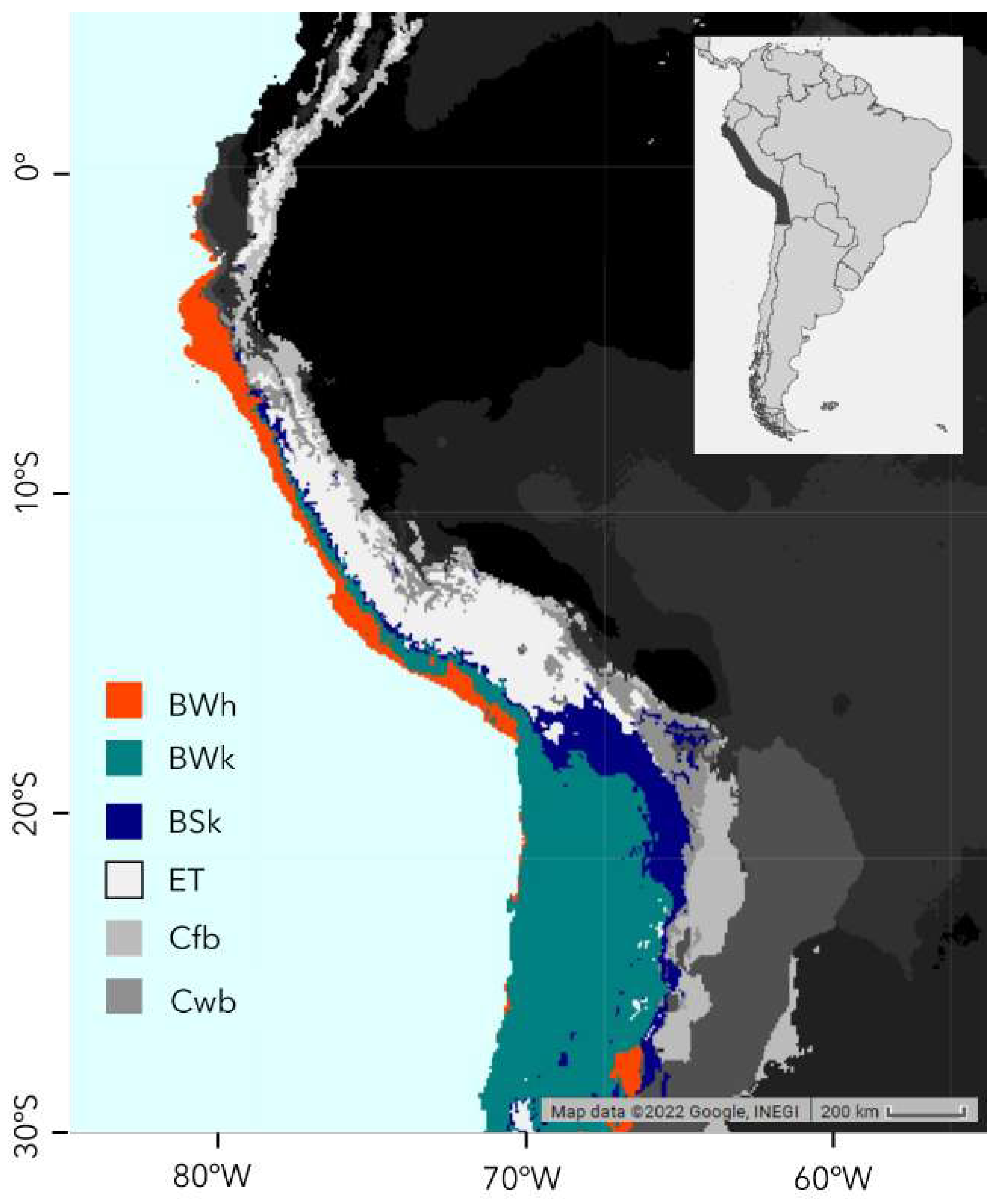
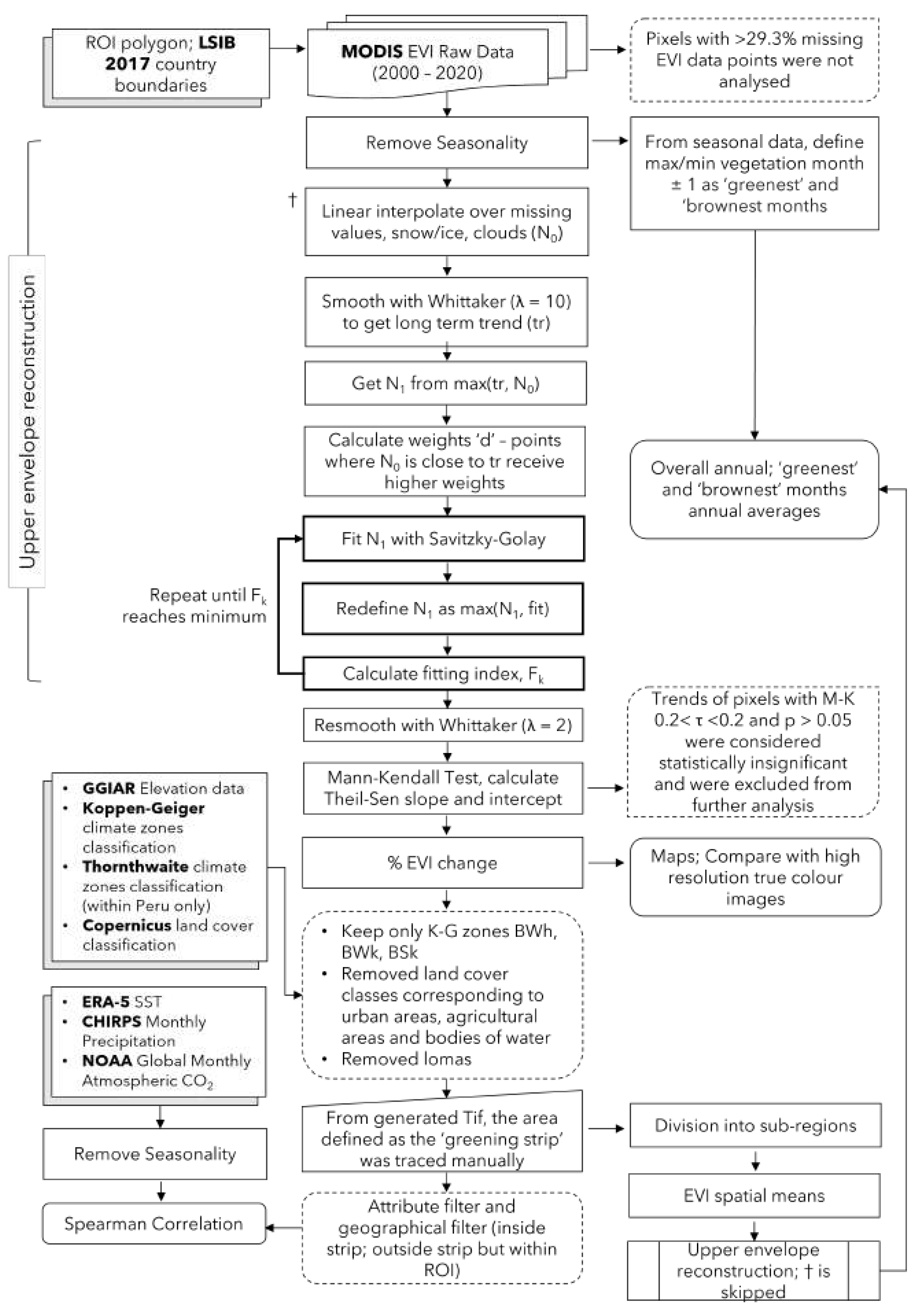
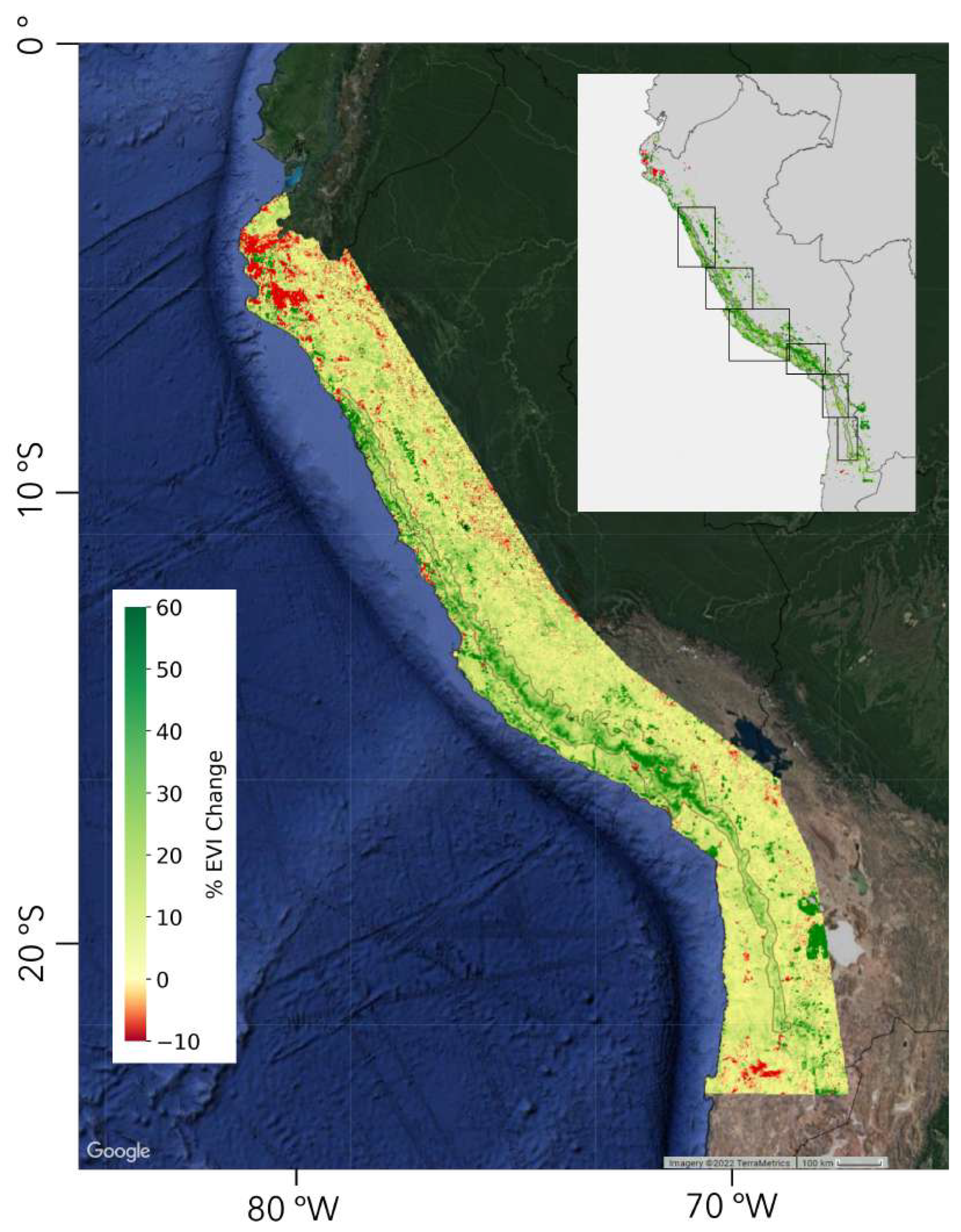
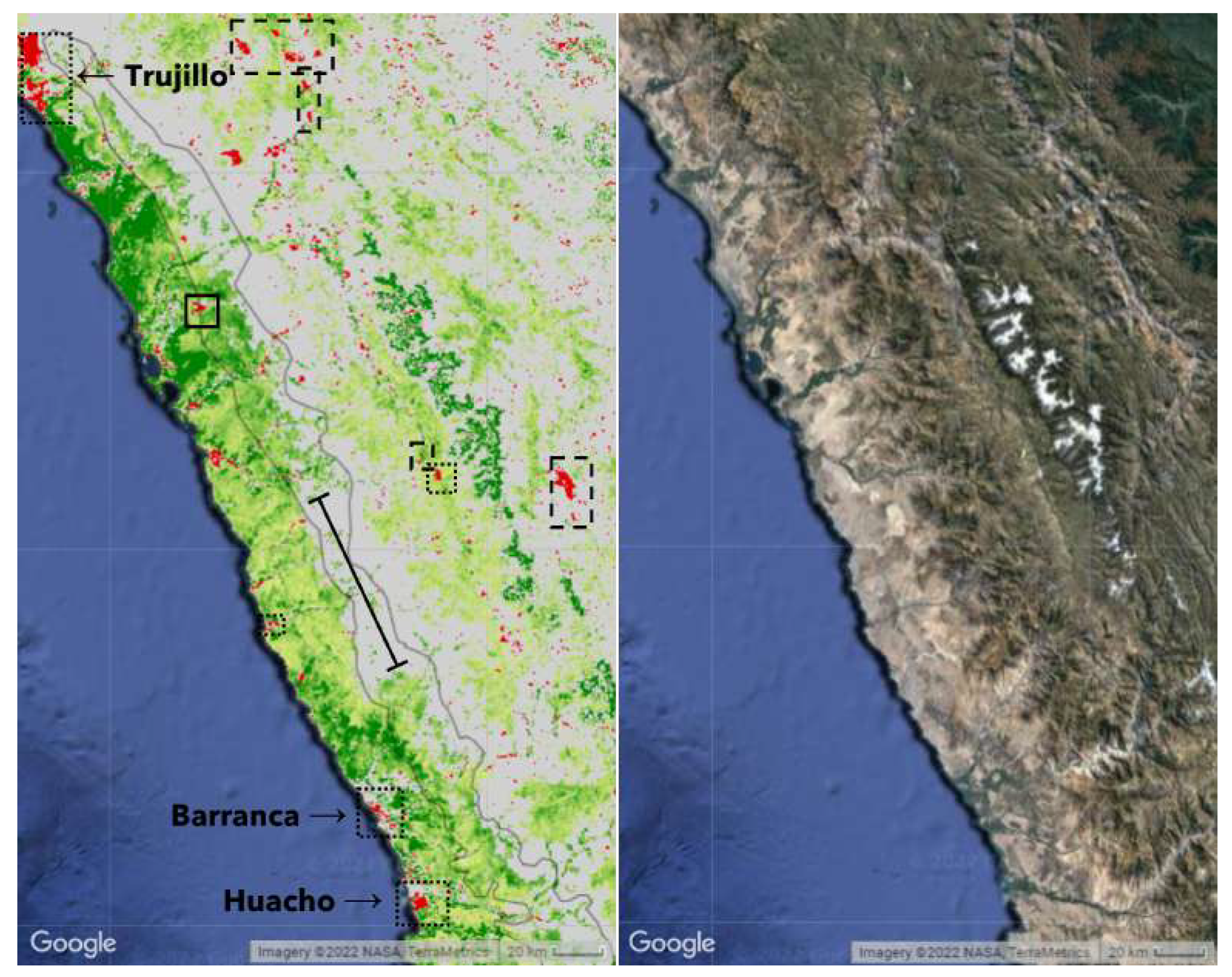
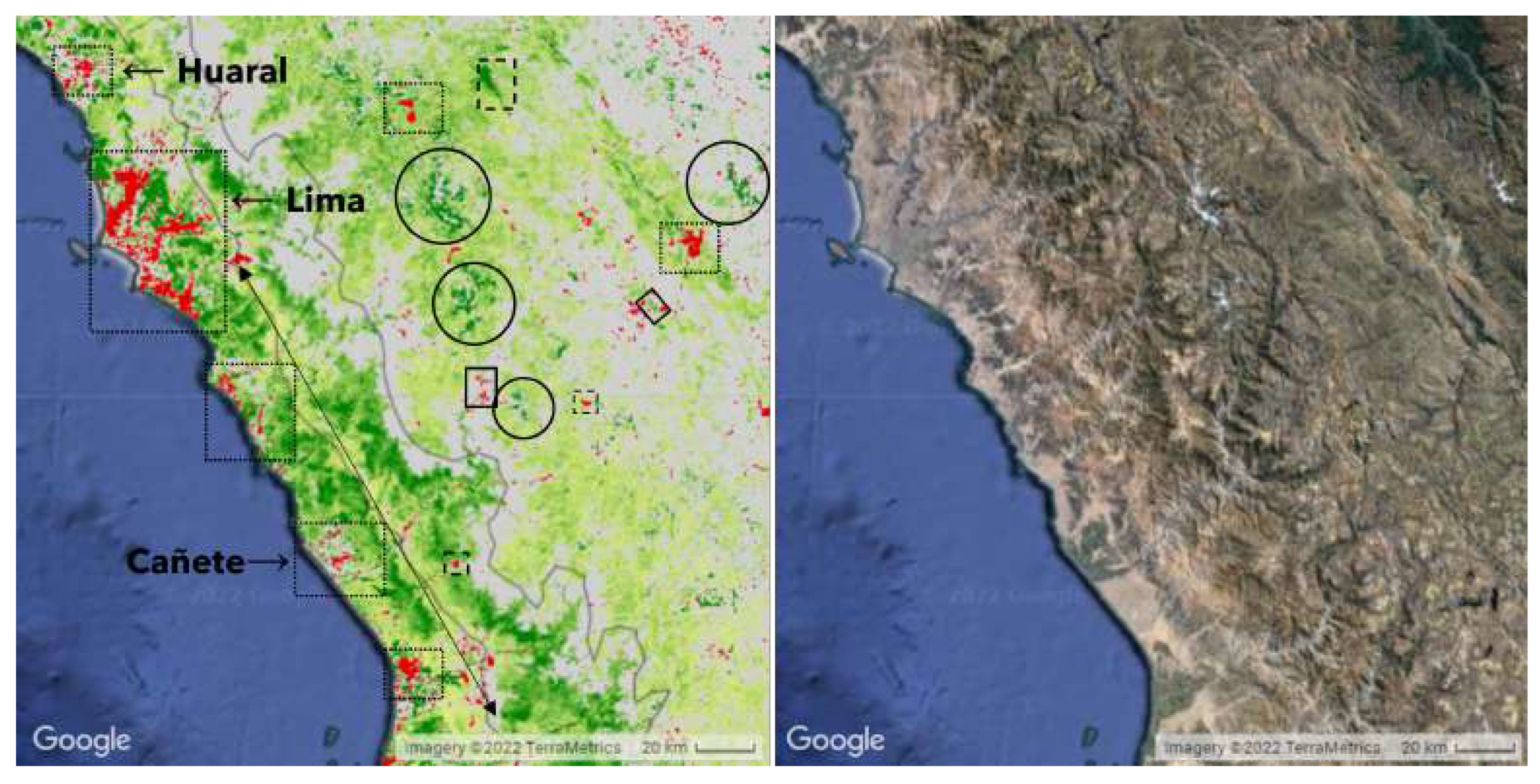
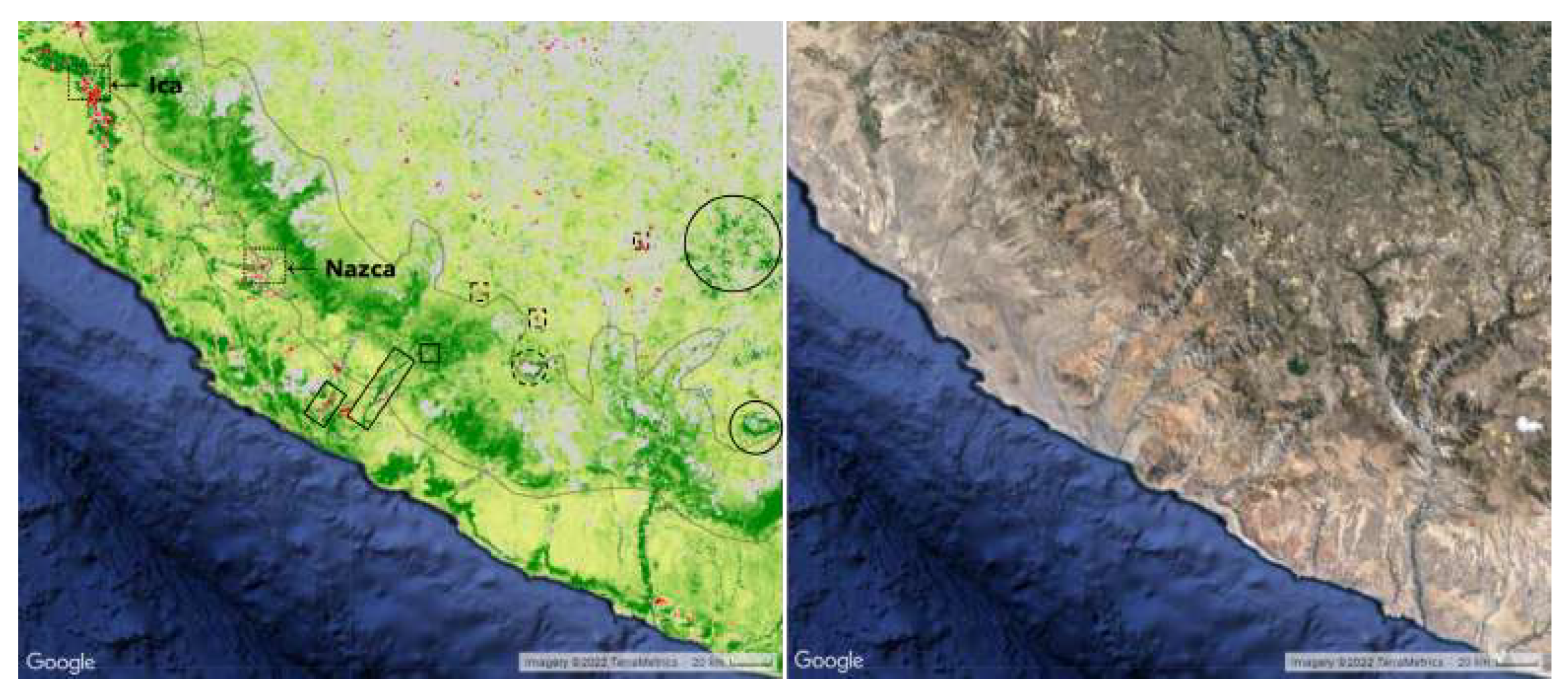
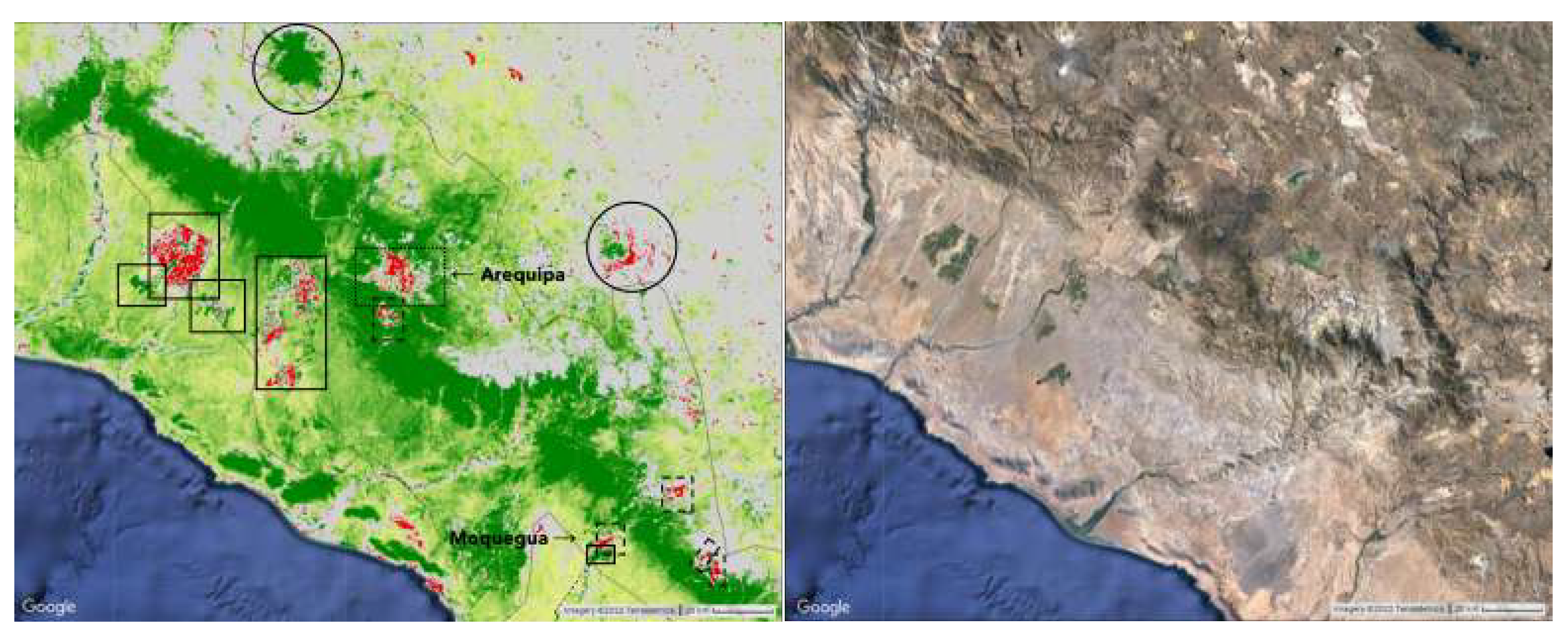
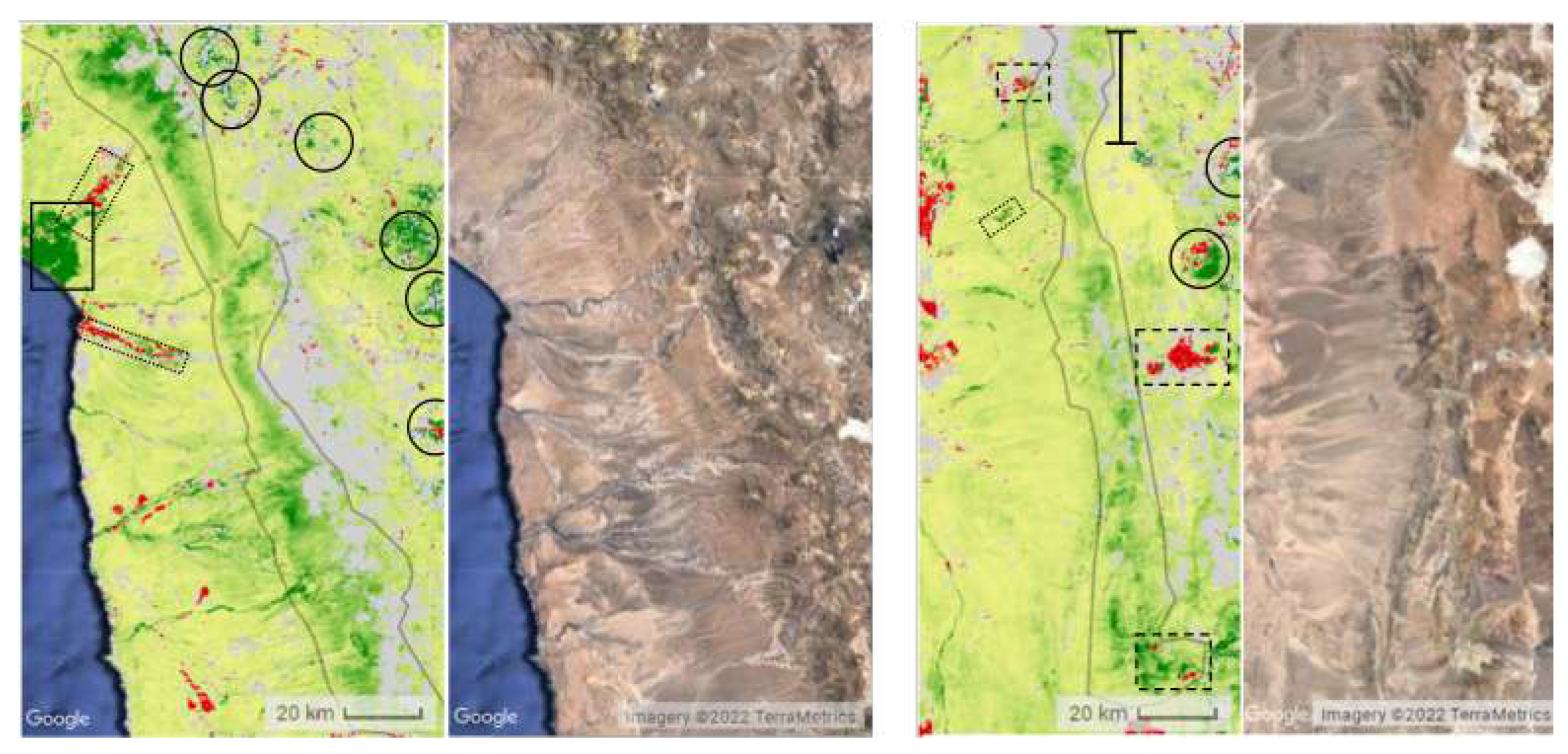
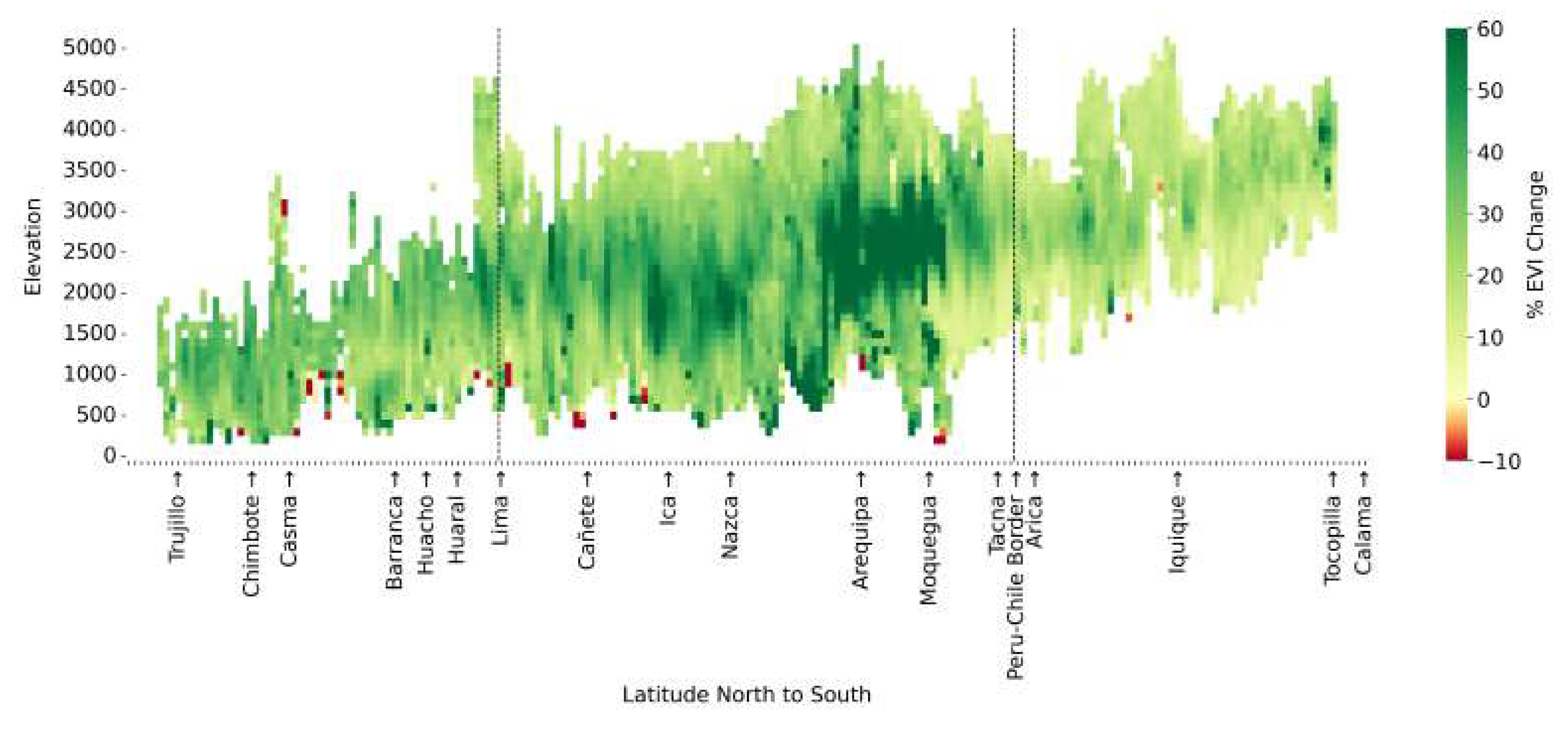
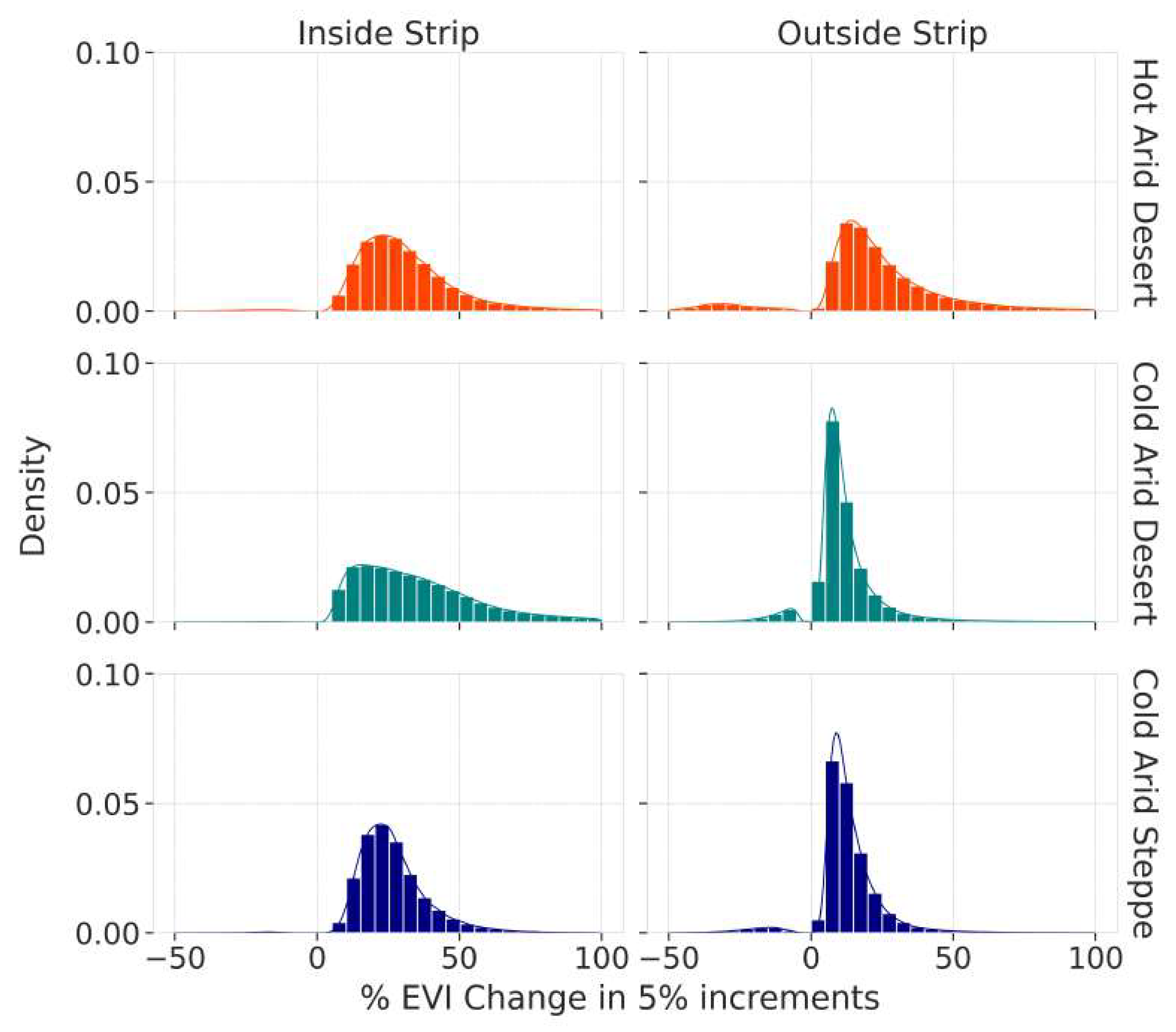
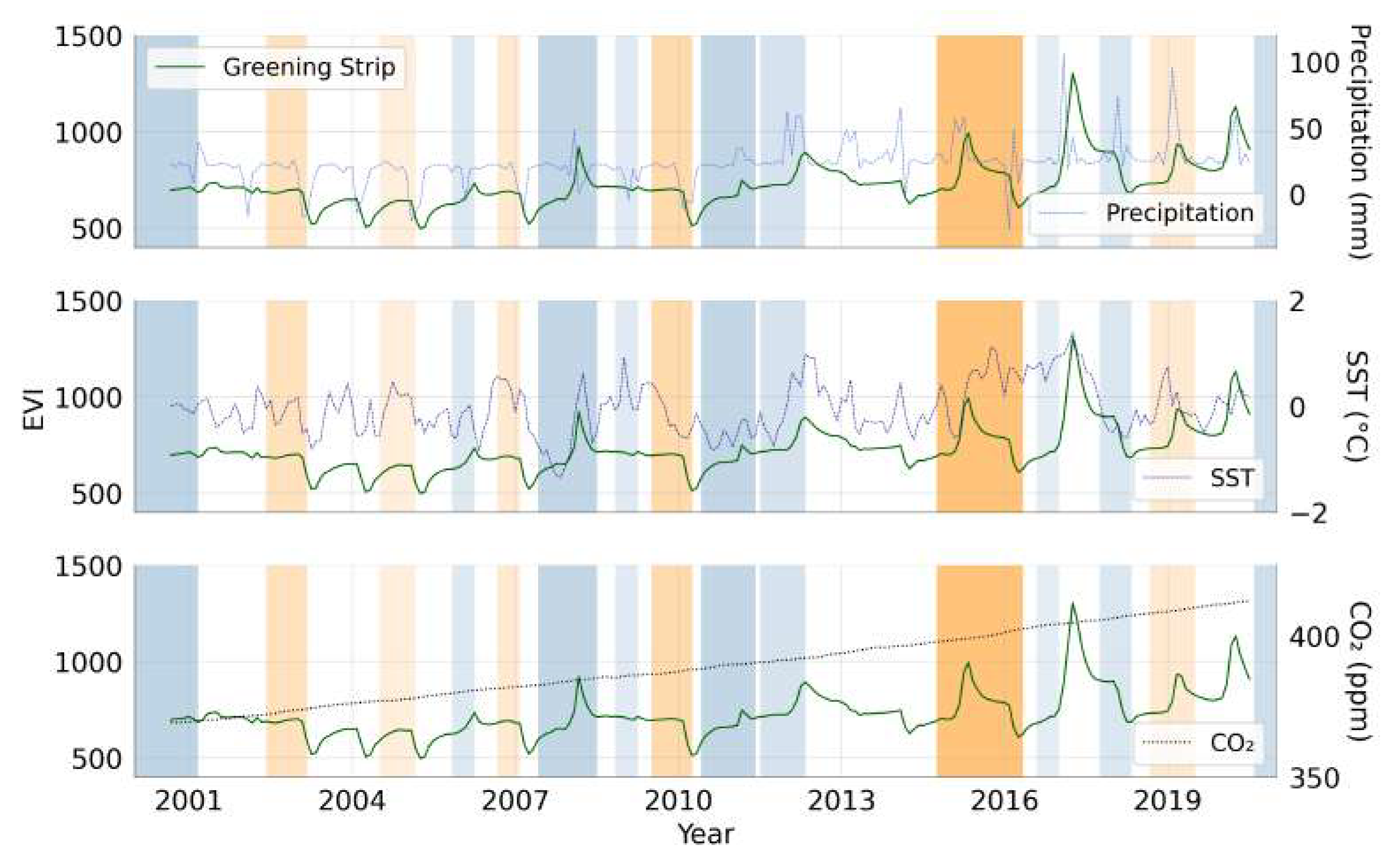
| Climate Zone | Code | Area Coverage |
|---|---|---|
| Arid, Desert, Cold | BWk | 30.0% |
| Polar, Tundra | ET | 29.2% |
| Arid, Desert, Hot | BWh | 16.7% |
| Arid, Steppe, Cold | BSk | 7.9% |
| Temperate, no dry season, warm summer | Cfb | 6.1% |
| Temperate, dry winter, warm summer | Cwb | 5.2% |
| Tropical, savannah | Aw | 2.0% |
| Arid, steppe, hot | BSh | 1.3% |
| Tropical, rainforest | Af | 0.9% |
| BWk | BSk | GS | GS_BWh | GS_BWk | GS_BSk | |
|---|---|---|---|---|---|---|
| BWh | 0.85 | 0.82 | 0.72 | 0.92 | 0.71 | 0.59 |
| BWk | 0.79 | 0.63 | 0.78 | 0.60 | 0.54 | |
| BSk | 0.69 | 0.79 | 0.67 | 0.64 | ||
| GS | 0.75 | 0.997 | 0.92 | |||
| GS_BWh | 0.72 | 0.60 | ||||
| GS_BWk | 0.91 |
| Region | Precipitation | SST | Global |
|---|---|---|---|
| BWh | 0.65 | 0.26 | 0.93 |
| BWk | 0.36 | 0.18 | 0.85 |
| BSk | 0.28 | 0.19 | 0.77 |
| GS | 0.53 | 0.38 | 0.60 |
| GS_BWh | 0.57 | 0.27 | 0.83 |
| GS_BWk | 0.52 | 0.39 | 0.58 |
| GS_BSk | 0.45 | 0.37 | 0.46 |
Disclaimer/Publisher’s Note: The statements, opinions and data contained in all publications are solely those of the individual author(s) and contributor(s) and not of MDPI and/or the editor(s). MDPI and/or the editor(s) disclaim responsibility for any injury to people or property resulting from any ideas, methods, instructions or products referred to in the content. |
© 2023 by the authors. Licensee MDPI, Basel, Switzerland. This article is an open access article distributed under the terms and conditions of the Creative Commons Attribution (CC BY) license (http://creativecommons.org/licenses/by/4.0/).





